St Kilian's Catholic Church
Bendigo
R.A. Randebrock., of Paderborn, Germany, 1872
2 manuals, 25 speaking stops, mechanical action
Restored Bellsham Pipe Organs, of Perth, 1981-2
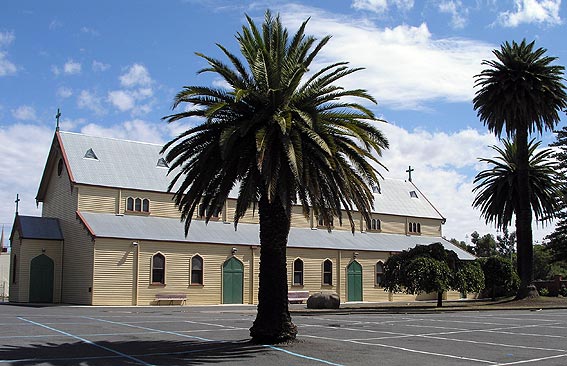
St Kilian's Church stands some two miles from where Dr Backhaus celebrated his first Mass in 1852. That Mass took place in a 'tent, He soon decided that -this location, in the midst of an area known as Irishtown, would be more suitable, so he moved here in the same year. The first permanent church measured 40ft x 16ft and was described by Bishop Goold as a "miserable slab affair covered with canvas". In 1856, work commenced on a new building, to the designs of the Melbourne firm of George and Schneider, and it was completed in 1857, Dr Backhaus contributing substantially to the cost, He also announced that he had ordered a pipe organ, as his gift to the church, but this did not arrive until 1872, On account of faulty foundations the-church did not survive, and it had to be demolished in 1887, The structural failure was probably the reason for the choice of timber for the present church, which replaced it in 1888.
St Kilian's Church was erected to the designs of Wilhelm Vahland, the father of Bendigo architecture. It is the largest wooden church in Australia and perhaps in the world. It was blessed on 1st July 1888 and is still structurally sound and in excellent condition. Many of the fittings of the old church, including Dr Backhaus' organ, were moved into the new building, St Kilian's Church is really the heart of Catholic Bendigo and is a much loved building. Even though Dr Backhaus did not know it, it stands as his memorial: he is buried within its grounds. On the occasion of the centenary celebrations commemorating the death of Heinrich Backhaus in 1982, a thorough restoration of the building was carried out. As you see it today, St Kilian's is much as it looked in 1888, with an updating to suit changed requirements and circumstances. Its beauty lies in its scale and simplicity, and in the quality of its wooden fittings and furnishings.

St Kilian is the patron saint of Westphalia, that part of Germany comprising ancient Franconia and Thuringia, where Dr Backhaus was born. Kilian was born in Mullagh in County Cavan in Ulster about 640 and was the principal Irish missionary to bring Christianity to the Franks. He was martyred in the year 689 with two companions and, to this day, St Kilian's Day, 8 July, is a great celebration in Warzburg, which grew up around the shrine of the Irish martyrs. It was an interesting twist to history, which certainly did not go unnoticed, that a German who probably owed his faith to Kilian, was here in a new land to care for the faith of Kilian's countrymen.
The patrons of the city of Paderborn in Westphalia, where Heinrich Backhaus was born, are the Virgin Mary, St Kilian and St Liborius. Liborius was the fourth Bishop of Le Mans, in France, and was martyred there in 397. Four hundred years later his relics were translated to Paderborn and installed in the new Cathedral. As with the transplantation of devotion to St Kilian in a new land, so it was with St Liborius, and we find Dr Backhaus, the priest from, Paderborn, dedicating a new church to the same St Liborius, in a patronal link extending back through many centuries. Mention might be made at this point, of the bonds of friendship which exist between the Archdiocese of Paderborn and the Diocese of Sandhurst something which would no doubt have greatly pleased Heinrich Backhaus.[1]
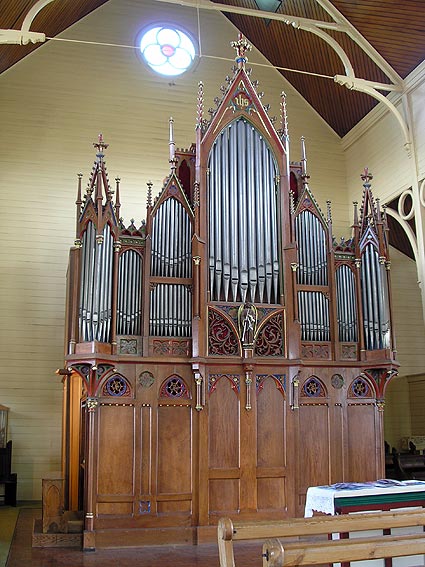
This organ was built in 1871 by R.A. Randebrock., of Paderborn, Germany, and was the gift of Dean Henry Backhaus. [2] It was installed in the west gallery of the original St Kilian's Church by George Fincham and opened on 11 December 1872 by H.F. Towle. [3] In 1887 the original stone church was declared unsafe, owing to subsidence caused by mining, and a new wooden church, designed by W.C. Vahland, opened on 1 July 1888. [4] The organ was moved to this building by George Fincham. [5] In 1896 some replacement pipes were supplied by'George Fincham [6] and in May 1906 the double-rise bellows were re-leathered by Fred Norden and F.J. Chapman, of Bishop & Sons London, who were in Bendigo at the time to erect the organ in Sacred Heart Cathedral. [8] From the late 1920's to 1955 the organ was maintained by Cyril Cowling, of Bendigo, who was later succeeded by Bob Carne. [8] By the late 1960s the organ had fallen into a lamentable state of disrepair and many pipes were missing, including both of the reed ranks and the Cornet, [9] From 1971 onwards various repairs were carried out by R.A. Anderson and Father J.P. Stockdale, and pipes for a new mounted Cornet were supplied by Hill, Norman & Beard. [10] In 1979 the two missing reed ranks were replaced by John Parker, [11]
The full restoration of this instrument, by Bellsham Pipe Organs, of Perth, began in late 1981, The whole instrument, including the casework, was transported to Perth. The casework and windchests were fully restored, and a new wind system designed and supplied. The mechanical action was renewed incorporating a new console chassis, keyboards and pedal board: however, the original drawstops, with porcelain inserts, were retained. All of the pipework was extensively repaired and missing pipes replaced. The pedal compass was extended from 25 to 29 notes, The original wooden gallery was demolished and the organ re-erected on a reinforced concrete platform at the west end of the church. [12]
This is one of the largest 19th century European organs in the country and especially notable for its elaborately carved casework, unusual console, located at the side of the instrument, and its conservative tonal scheme, which has been preserved without alteration, It appears and sounds to great advantage in its new position at floor level in this very large wooden church.
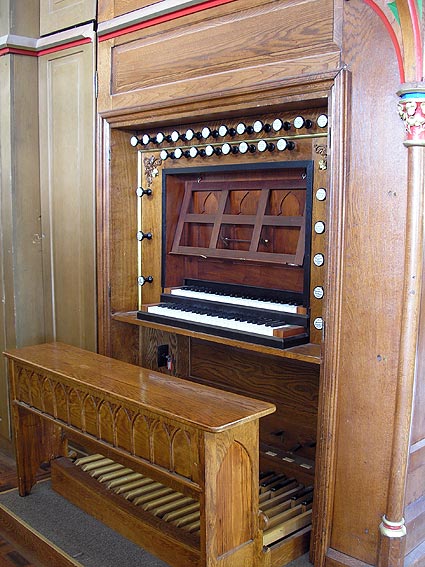
| HAUPTWERK (Manual II) Bourdon Principal Hohlflöte Gedackt Gamba Principal Gedacktflöte Quinte Octav Mixture 15.19.22 Cornett 8,12,15.17 Trompete UNTERWERK (Manual I) Geigen principal Portunal Lieblich gedackt Fernflöte Salicional Octav Querflote Flageolet PEDAL Violonbass Subbass Principalbass Gedacktbass Posaune COUPLERS unterwerk / hauptwerk ø hauptwerk / pedal ø pedal octav koppel ø |
16 8 8 8 8 4 4 2-2/3 2 III IV 8 8 8 8 8 8 4 4 2 16 16 8 8 16 |
gvd.bass * * gvd.bass gvd.bass wd met * |
compass: 54/29
mechanical action
ø operated by foot levers [13]
* replacement ranks
[1] Notes., Tom Hazell,
[2] Builder's name and date inscribed on scroll born by statue of St Liborius at centre of case; notes, John Maidmente
[3] E.N. Matthews, Colonial organs and organbuilders. Carlton: Melbourne University Press, 1969 p.164.
[4] lbid.
[5] Ibid.
[6] Ibid.
[7] Geoffrey Revell. "The Randebrock organ of St Kilian's Catholic Church, Bendigo, Victoria, and its restoration." OHTA News. vol. 7. no.4 (October 1983). p.4.
[8] Ibide., p.5.
[9] Notes, John Maidment.
[10] Revell, op.cit., p.5.
[11] Ibid.
[12] Ibid. p.4-9. this article gives a complete account of the restoration by the organbuilder responsible for this work
[13] Ibid. p.9.
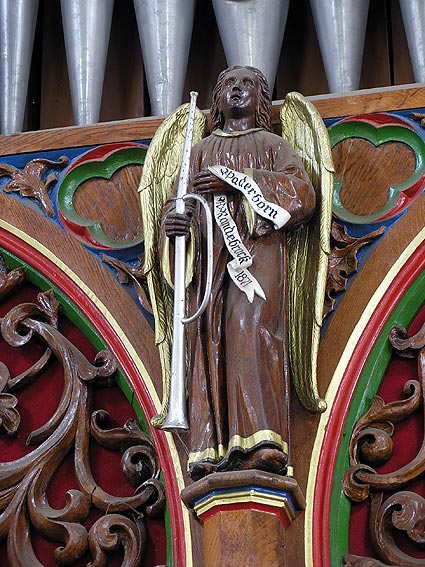 |
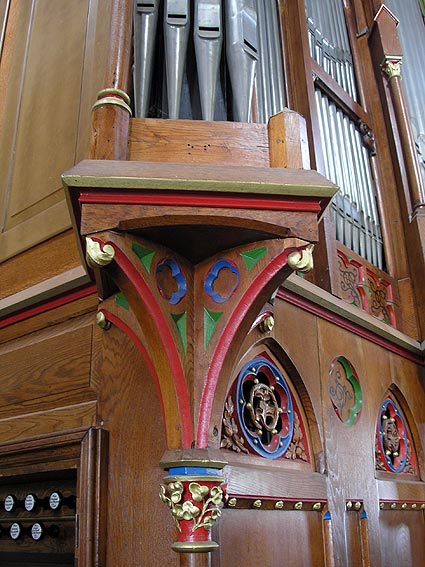 |
|
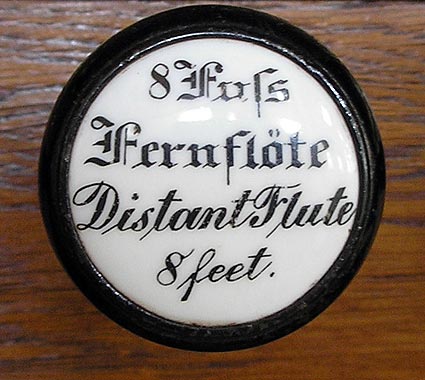 |
||
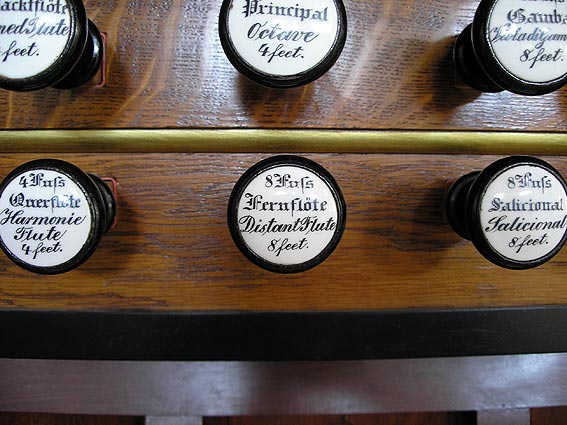 |
||
Pictures above supplied by Simon Colvin
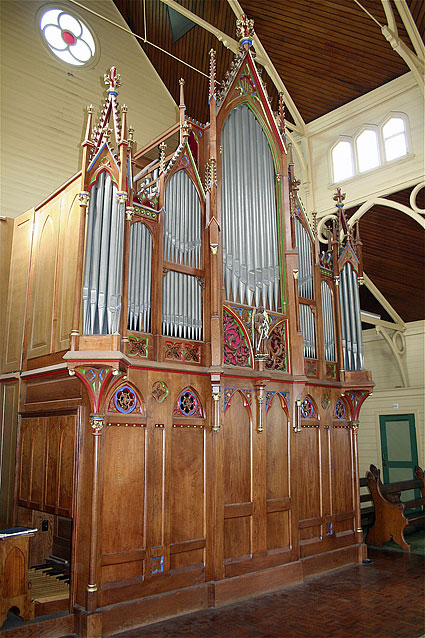 |
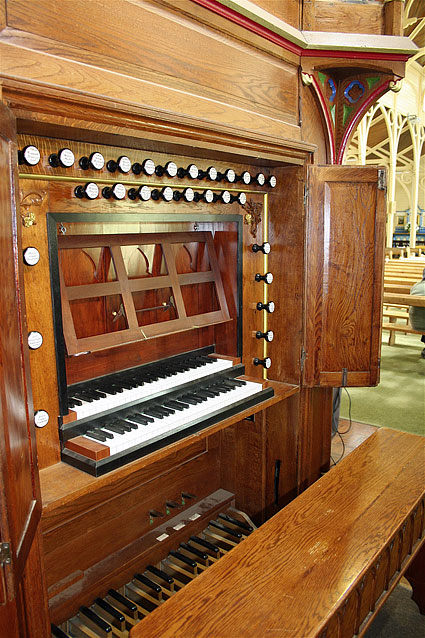 |
|
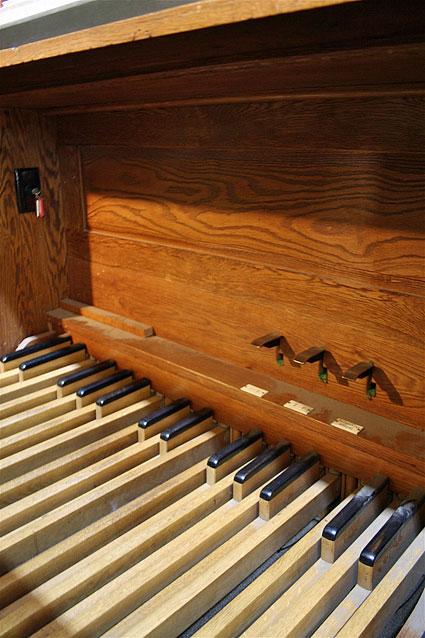 |
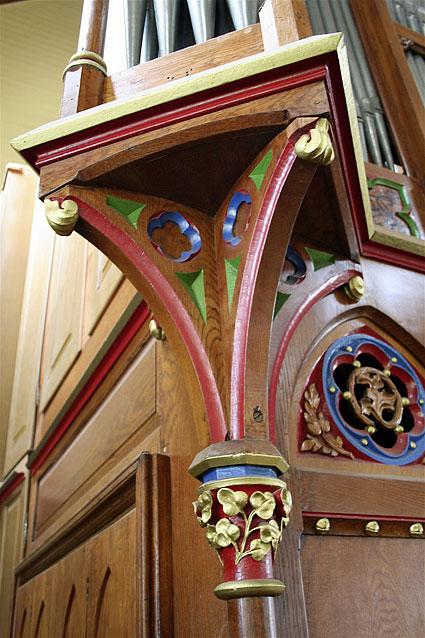 |
|
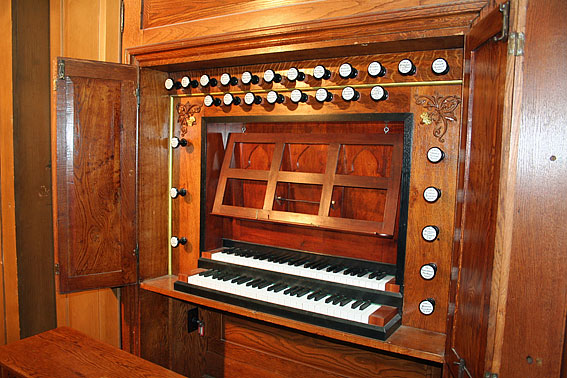
|
||
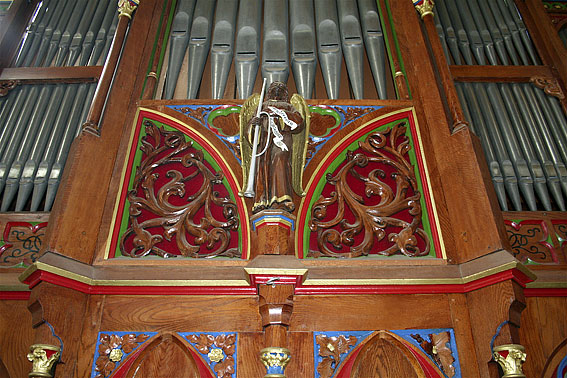
|
||
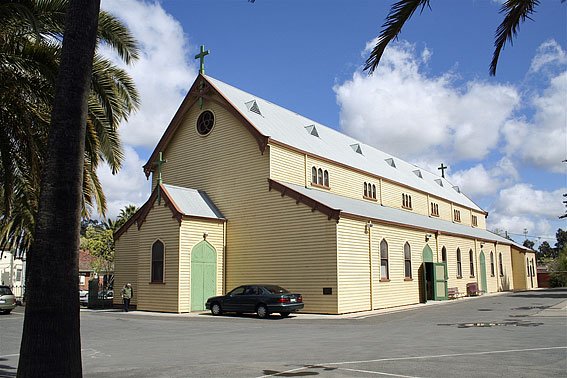
|
||
Photos above: Trevor Bunning (Oct. 2008)